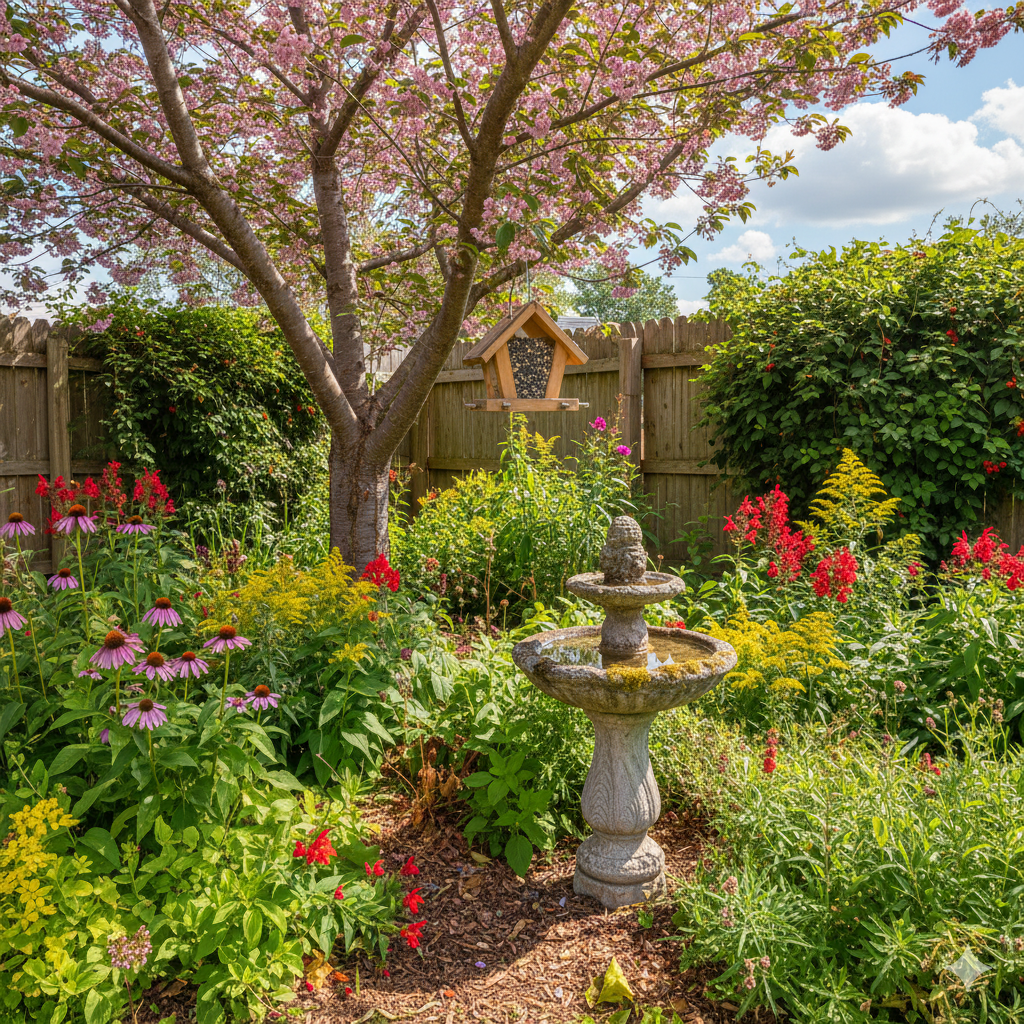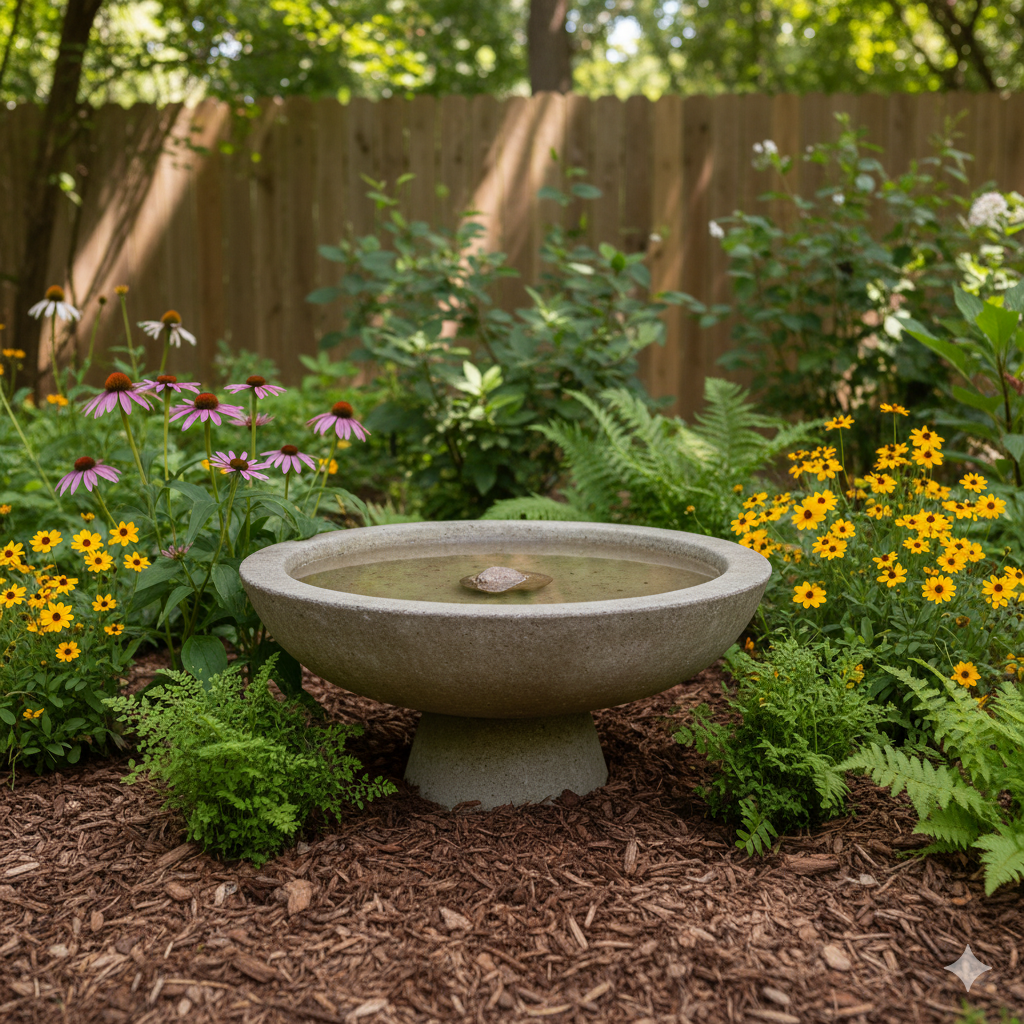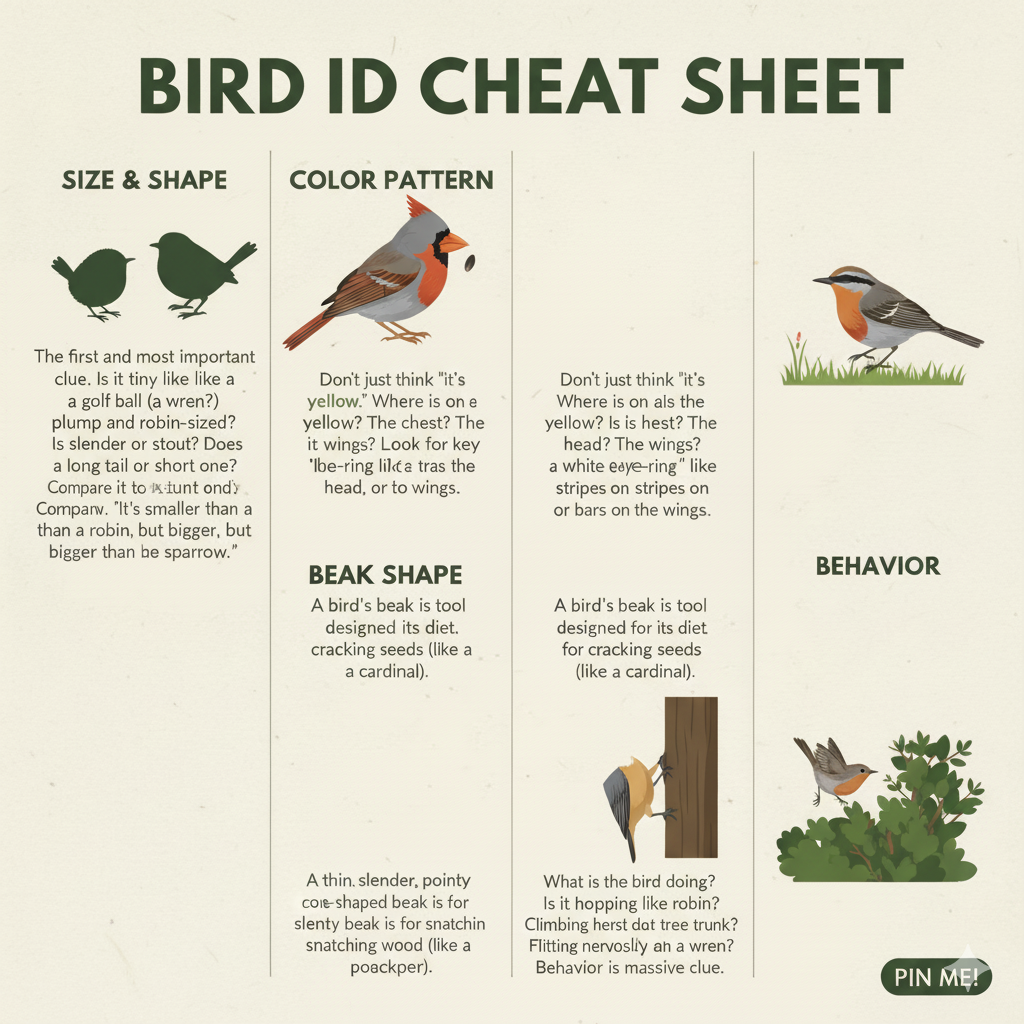Have you ever been washing dishes and been stopped in your tracks by a flash of brilliant red at the window? Or maybe you’ve heard a cheerful, unfamiliar song while sipping your morning coffee on the porch.
That, right there, is the magic of birdwatching. It’s a quiet thrill, a moment of connection to a world bustling with life just outside your door. If you’ve ever felt a spark of curiosity about those feathered visitors, you’re in the perfect place. This isn’t a hobby that requires expensive trips or complicated gear; it’s one you can start today, from your favorite chair.
Welcome to The Ultimate Guide to Backyard Birdwatching for Beginners, where we’ll show you everything you need to know to turn your yard or balcony into a vibrant theater of nature.
Why You’ll Love Birdwatching (It’s More Than Just Watching Birds!)
Before we dive into the “how-to,” let’s talk about the “why.” Backyard birdwatching is more than just a passive activity; it’s an experience that enriches your daily life in so many ways.
- It’s a Stress-Buster: In our busy, screen-filled lives, taking just ten minutes to quietly observe a chickadee flitting from branch to branch is a powerful form of mindfulness. It pulls you into the present moment and helps the day’s worries melt away.
- It’s a Fun Puzzle for Your Brain: Learning to identify birds is like a fun, ongoing detective game. You’ll start noticing subtle differences in color, song, and behavior, sharpening your observation skills in a way that’s both challenging and incredibly satisfying.
- It Connects You to Nature: You don’t need to hike into a deep forest to feel connected to the natural world. Birdwatching reveals the changing seasons and the delicate ecosystem that exists right in your own neighborhood.
- The Thrill of Discovery: Nothing beats the excitement of identifying a new bird for the first time! That “Aha!” moment when you match a bird in your yard to a picture in your field guide is a pure, simple joy that never gets old.
Getting Started: The Only 3 Things You Absolutely Need
One of the best parts about birding is its low barrier to entry. You don’t need a closet full of expensive equipment. In fact, to truly start your journey, you only need three simple things.
1. A Pair of Binoculars
While your eyes are a good starting point, binoculars are the magic key that unlocks the details. They let you see the subtle stripe above an eye, the faint barring on a chest, or the shape of a beak—all crucial clues for identification. When you’re just starting out, you don’t need a top-of-the-line pair. Look for a model with numbers like 8×42. This is a fantastic all-around specification for birding, offering a great balance of magnification (8x) and brightness (42). This simple tool is essential when it comes to choosing binoculars for birding that will serve you well for years.
2. A Field Guide or an App
How do you know what you’re looking at? You need a reference!
- Field Guide (Book): Traditional, beautifully illustrated books organized by bird family. They are wonderful to flip through and don’t require a battery.
- Bird Identification App: For most beginners, this is the way to go! Apps are incredibly powerful and easy to use. The Merlin Bird ID app from the Cornell Lab of Ornithology is a game-changer. It can help you identify a bird from a photo or by answering a few simple questions. It even has a feature that listens to a bird’s song and tells you what it is!
3. A Simple Notebook
This might seem old-fashioned, but it’s one of the most rewarding parts of the hobby. Get a simple notebook and a pen to create your own “birding journal.” Jot down the date, the weather, and the birds you see. Make notes about their behavior. Was the robin pulling a worm from the lawn? Was the woodpecker chasing a rival? These notes will become a treasured record of your discoveries and help you become a better birder over time.
Your Backyard Birdwatching Checklist
Ready to get started? Here’s a simple checklist to make sure you have everything you need to create a birding haven and enjoy your new hobby.
(This would make a great Pinterest graphic!)
Essential Gear:
- [ ] Binoculars (8×42 is a great start)
- [ ] Bird Identification App (like Merlin Bird ID)
- [ ] A dedicated notebook or journal
- [ ] A comfortable chair with a good view!
Yard & Balcony Essentials:
- [ ] At least one bird feeder
- [ ] A bag of black-oil sunflower seeds
- [ ] A clean source of water (bird bath or a simple dish)
- [ ] A patch of natural shelter (a shrub, tree, or even a potted plant)
Love these tips? Pin this guide to your ‘Outdoor Hobbies’ board for later!
Step 1: Create a Bird-Friendly Paradise
Now for the really fun part! If you want to see more birds, you need to think like a bird. What do they need? The same three things we all do: food, water, and shelter. Here’s how to attract birds to your yard.

Offer the Best Food on the Block
A reliable food source is the number one way to get birds to visit your yard regularly.
- The Best All-Around Seed: If you only buy one type of bird seed, make it black-oil sunflower seed. Its thin shell is easy for small birds to crack, and its high fat content is loved by a huge variety of species, from finches and chickadees to cardinals and jays.
- Best Bird Feeders for Beginners:
- Hopper/House Feeder: These look like little houses and are great for holding lots of seed, protecting it from the weather. Perfect for cardinals, finches, and sparrows.
- Tube Feeder: These are hollow tubes with small perches, ideal for smaller birds like chickadees and goldfinches.
- Suet Cage: Suet is a high-energy cake of rendered fat, perfect for winter. It attracts woodpeckers, nuthatches, and wrens.
Provide a Water Source
Water is just as important as food, if not more so! Birds need water for drinking and for preening (keeping their feathers clean and healthy).
- A Simple Bird Bath: A shallow basin is all you need. It can be a classic pedestal style, a hanging dish, or even a shallow ceramic saucer placed on the ground.
- Keep it Clean: Change the water every couple of days to keep it fresh and prevent algae growth.
- Pro Tip: Birds are highly attracted to moving water. Adding a small solar-powered “wiggler” or fountain to your bird bath will act like a flashing neon sign, inviting birds from all over the neighborhood.

Create Shelter and a Safe Haven
Birds feel safest when they have a place to hide from predators and take cover from bad weather. You don’t need a huge forest—a little bit of cover goes a long way.
- Plant Native: The best thing you can do is plant native trees, shrubs, and flowers. These plants provide the right kinds of seeds, berries, and insects that local birds evolved to eat.
- Don’t Be Too Tidy: Leave a small brush pile in a corner of your yard or let the leaves accumulate under a hedge. This provides critical shelter and a place for ground-feeding birds like sparrows and towhees to forage for insects. On a balcony, a few large potted plants or a trellis with vines can serve the same purpose.
Step 2: The Art of Patient Observation
Your yard is now a five-star resort for birds. It’s time to sit back and enjoy the show. This is where the core practice of birdwatching begins.
When and How to Watch
- Timing is Everything: Birds are most active during the early morning (just after sunrise) and the late afternoon. This is when they are out foraging for food.
- Be Still and Quiet: Find a comfortable spot with a good view of your feeders and bird bath. The less you move, the more comfortable the birds will be. Just sit, sip your drink, and let the world come to you. You’ll be amazed at what you start to notice.
Listen Before You Look
One of the most important birdwatching tips is to use your ears. You will often hear a bird long before you see it. At first, it might just sound like background noise. But soon, you’ll start to recognize different chips, calls, and songs. Is it a high-pitched tsee-tsee-tsee? Maybe a chickadee. Is it a loud, boisterous Jay! Jay!? That’s a Blue Jay. Learning sounds adds a whole new dimension to your birdwatching.
Step 3: Beginner’s Guide to Bird Identification
Okay, a bird has landed on your feeder. It’s small and brown. Now what? Identifying birds can feel daunting, but it’s just a matter of knowing what to look for. Think of it as a four-point inspection.
Bird ID Cheat Sheet: 4 Things to Look For

(This is a perfect section for a “Pinnable” infographic!)
- Size & Shape: The first and most important clue. Is it tiny like a golf ball (a wren?) or plump and robin-sized? Is it slender or stout? Does it have a long tail or a short one? Compare it to a common bird you know. “It’s smaller than a robin, but bigger than a sparrow.”
- Color Pattern: Don’t just think “it’s yellow.” Where is the yellow? Is it on the chest? The head? The wings? Look for key “field marks” like a white eye-ring, stripes on the head, or bars on the wings.
- Beak Shape: A bird’s beak is a tool designed for its diet. A short, thick, cone-shaped beak is for cracking seeds (like a cardinal). A thin, slender, pointy beak is for snatching insects (like a warbler). A strong, chisel-like beak is for drilling wood (like a woodpecker).
- Behavior: What is the bird doing? Is it hopping on the ground like a robin? Climbing head-first down a tree trunk like a nuthatch? Flitting nervously in a bush like a wren? Behavior is a massive clue.
Meet Your New Neighbors: 10 Common Backyard Birds to Spot
To get you started, here is a list of some of the most widespread and recognizable common backyard birds in North America.
- Northern Cardinal: You can’t miss the brilliant, all-red male! Females are a soft, warm brown with reddish tinges.
- American Robin: A familiar sight on lawns, with a gray back, round reddish-orange belly, and a cheerful song.
- Blue Jay: A loud, bold, and incredibly smart bird with a beautiful pattern of blue, white, and black feathers and a crested head.
- Mourning Dove: A graceful, slender bird with soft, tan-gray plumage and a gentle, cooing call that sounds sad.
- Downy Woodpecker: North America’s smallest woodpecker, a cute black-and-white bird you’ll see clinging to tree trunks and suet feeders.
- House Finch: A social little bird. Males have a rosy red-to-orange head and chest, while females are plain grayish-brown.
- American Goldfinch: A tiny burst of sunshine! In summer, the male is a stunning bright yellow with a black cap and wings.
- Black-capped Chickadee: A curious and acrobatic little bird with a black cap and “bib,” white cheeks, and a gray back. Famous for its chick-a-dee-dee-dee call.
- White-breasted Nuthatch: An agile “upside-down” bird, often seen climbing head-first down tree trunks with its blue-gray back and white belly.
- European Starling: An iridescent, speckled bird that often travels in large, noisy flocks. They are expert mimics.
Taking Your Hobby to the Next Level
Once you get comfortable, you might find yourself wanting more. Here are a couple of ways to deepen your new passion:
- Keep a Life List: This is a running list of every bird species you successfully identify. It’s a fun, personal challenge that you can add to for the rest of your life.
- Become a Citizen Scientist: Your sightings are valuable data! You can contribute to real scientific research by reporting what you see through programs like Project FeederWatch or by submitting your checklists to eBird.org. It’s a wonderful way to make your hobby count.
Conclusion
The world of birds is waiting for you, and it’s closer than you think. It doesn’t require anything more than a little patience, a little curiosity, and a willingness to look up. By getting a few essentials, creating a welcoming space in your yard, and practicing the art of patient observation, you’ll unlock a source of endless wonder and joy. So fill up that feeder, grab your binoculars, and get ready to meet your new neighbors. The Ultimate Guide to Backyard Birdwatching for Beginners is just your first step into a larger, more beautiful world. Happy birding!
